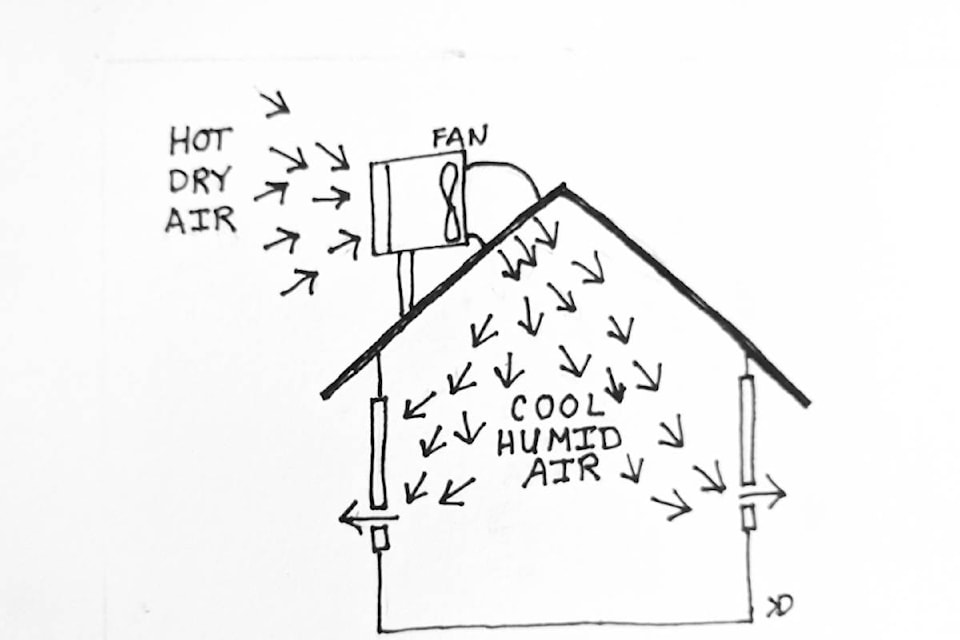I left my heart (or maybe just my evaporative cooler) in the desert
Global warming is creeping up on the Okanagan, in the form of higher average summer temperatures and longer summers. Climate data and modeling show that our hottest summer days have moved from 34.8 C in 1980 to 36.1 C in 2020. A better measurement for summertime air conditioning is “cooling degree days”. You can think of cooling degree days as a combination of how hot it is and how many days are hot. It is a good measure of how much electricity you use for air conditioning (heating is measured by warming degree days). In 1980 we had 197 cooling degree days. Now we have 280 cooling degree days (all data from climatedata.ca).
Data and models for climate change in the Okanagan
What is really distressing is that this is a feedback loop: Hotter weather and more hot days means more air conditioning. Your midday air conditioning doesn’t come from carbon-free hydro power. It’s hard to turn dams on and off, so for short term power needs power companies have “peaker plants” that use natural gas. Burning natural gas adds to carbon in the atmosphere, creating hotter summer weather. But AC (sometimes referred to as “refrigerated air” or “freon air conditioning”) isn’t the only way to create an oasis in the desert.
Freon air conditioning isn’t the only way to create an oasis in the desert
The Okanagan is not my first desert experience. I lived ten years in New Mexico, which is similarly dry and hot during the summer. There are things I miss about New Mexico. Number one is fire-roasted green chiles, but a close second is the evaporative cooler. I associate evaporation cooling with joy, summers, listening to wildlife and thunderstorms, and iced tea.
READ MORE: Report: Are British Columbians addicted to air conditioning? AC costs increasing
Evaporative coolers don’t cause the feedback loop where the hotter days leads to more electricity use which means carbon emitted. They use a fan and a small electric pump to cool your house, requiring about a fifth of the energy of refrigerated air.
Generally evaporative coolers have one intake and the cool air is guided through the house by cracking open windows. Need it cooler in the kitchen? Open the kitchen window wider, close the one in the bedroom. Those windows bring in the smells (lilacs, rain on sage, BBQs) and sounds of summer (birdsong in the morning, owls at night, conversations of neighbors). The humidity evaporative coolers to indoor air is a welcome relief during the dry summer.
READ MORE: Researchers look at humidity as a weapon in the fight against airborne viruses
Another way evaporative coolers keep you in touch with nature is that they set a relative, rather than an absolute temperature. Evaporative coolers cool the house 15-25 F degrees below the outside temperature. If you intend to hide inside all summer long, emerging only to water your plants after dusk, a set temperature makes sense. If you are in and out, to the store, to the beach, to ride the KVR, then having the temperature be a difference rather than absolute is much better. Your body acclimates to summer and the shock of the outside air doesn’t flatten you. With an evaporation cooler the cool of the house is a relief but doesn’t require a sweater and a tuque.
With an evaporation cooler the cool of the house is a relief but it doesn’t require a sweater and a touque.
There are disadvantages to evaporative coolers. They are simple to operate and install but because it involves water, when something goes wrong, something gets wet. Like any humidifier if it isn’t cleaned regularly it can grow stuff you don’t want to breathe. I know people allergic to gluten, peanuts, strawberries and all fruits with pits. In ten years, I never met anyone who was allergic to evaporative coolers.
Missed last week’s column?
Dyer: Community solar gardens
About Kristy Dyer:
Kristy Dyer has a background in art and physics and consulted for Silicon Valley clean energy firms before moving (happily!) to sunny Penticton. Comments to Kristy.Dyer+BP@gmail.com
